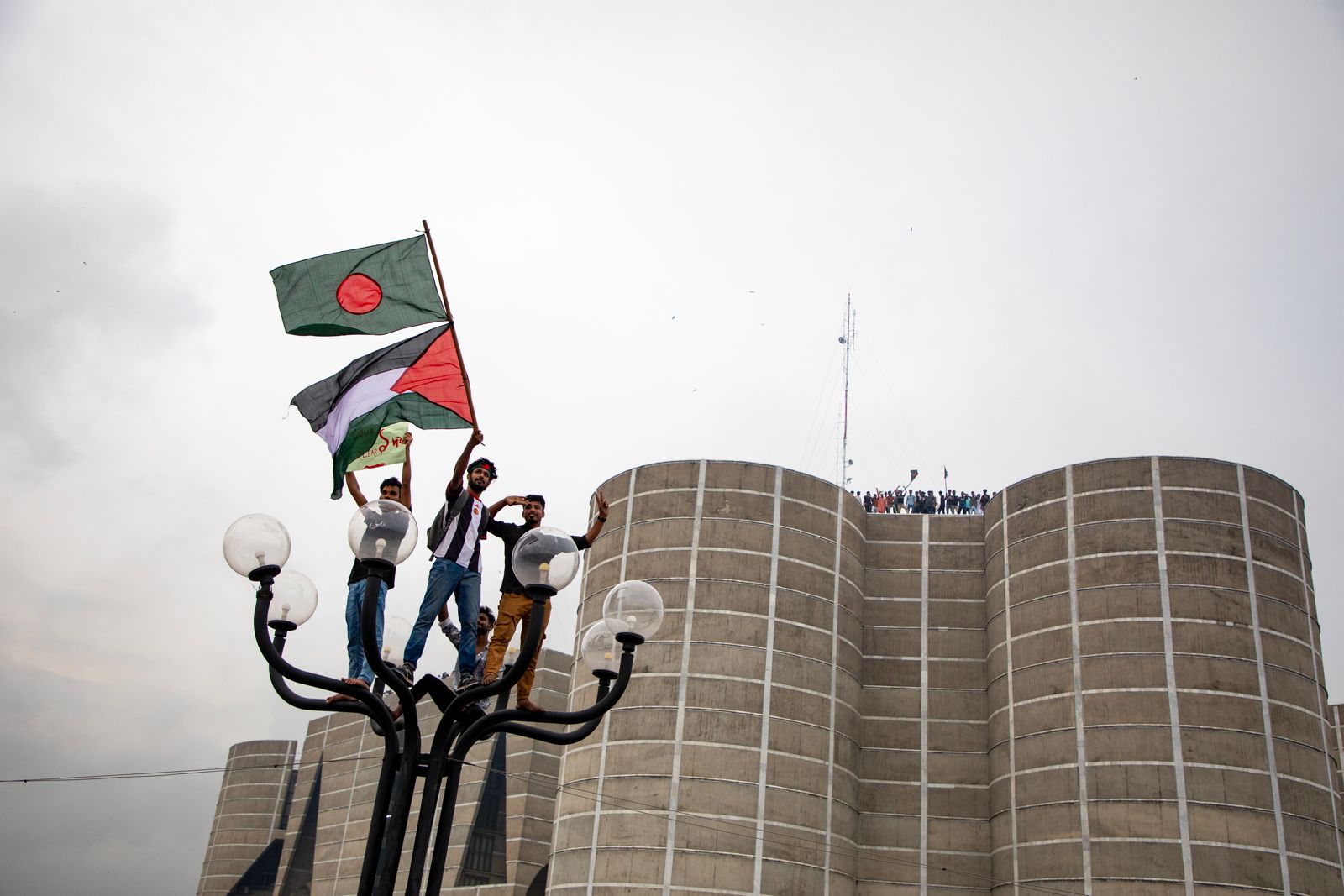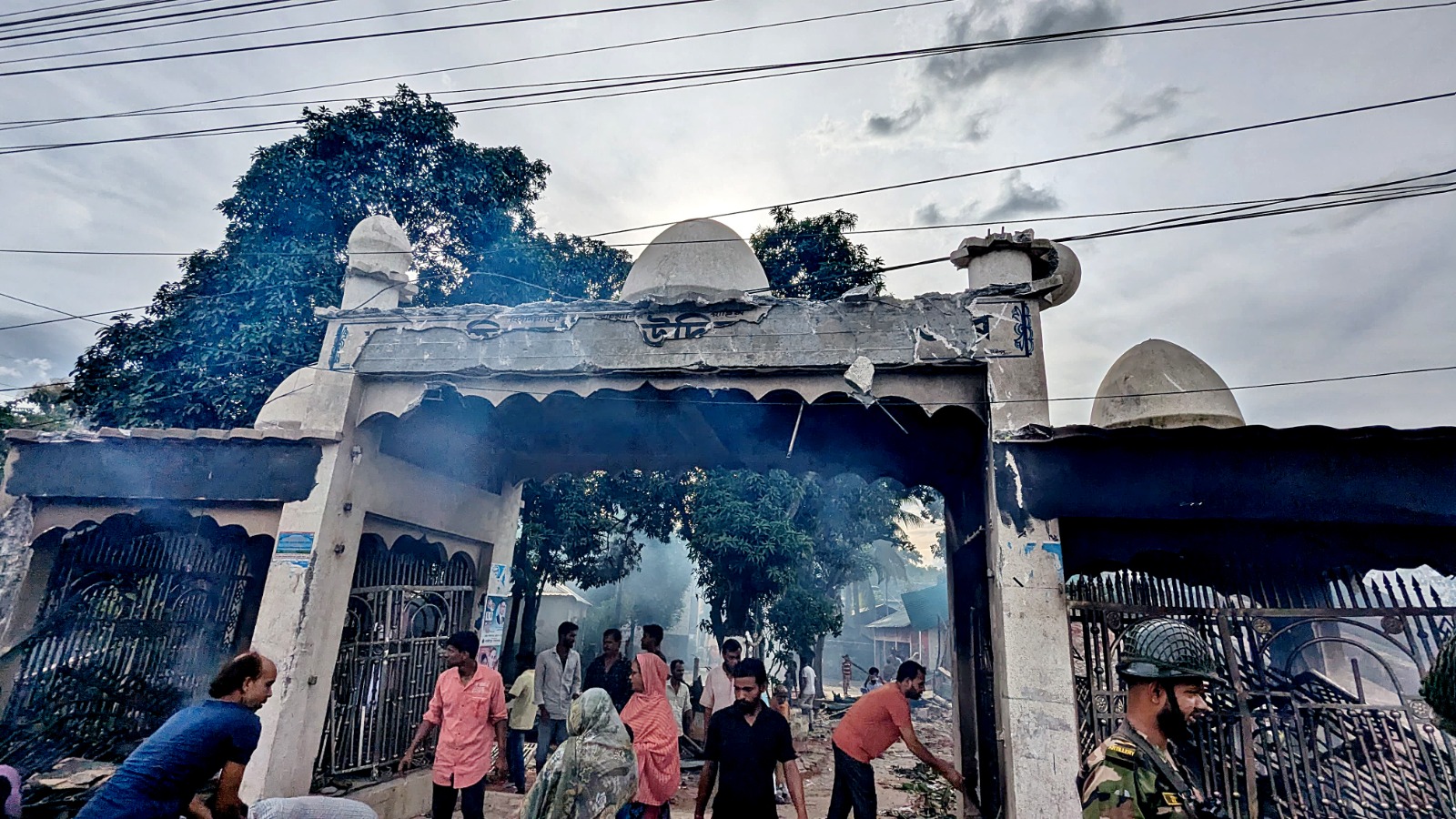All that is solid melts into the air: The July uprising and a state in transition
Seuty Sabur and Shehzad M Arifeen
“Everything was forever, until it was no more.” Almost two months after Sheikh Hasina’s ignominious departure, the title of Alexei Yurchak’s (2006) book on the experience of the collapse of the Soviet Union could just as easily describe the end of the Awami League’s 15-year-old hold on power. Looking back, the days of road skirmishes, tear gas, sound grenades, helicopters, rubber bullets and blood, curfew and internet blackout, the long march, the departure, the scenes from Gono Bhaban—everything seems like a bad dream, a collective hallucination. Of course, to the wounded and those who lost their loved ones, who will carry the scars of those days forever, there is nothing dreamlike about it.
All empires fall. We have written previously about how the Awami League’s elite club politics and sheer disdain for the citizenry paved the way for the July uprising and their own demise. Just as the people of this land once rejected the Muslim League, defied the Pakistani state, rebelled against the ’72 regime, and brought about the end of military/autocratic rule in the 90s, they have overthrown another set of overlords for much the same reasons—for pitting the state against the nation and making enemies of their own people. Students, workers, teachers and so many others courted imprisonment, torture, injury and death, all to reclaim the state and free it from the hold of the “chosen ones,” not to install another in their place. Although we are still counting the bodies, by most accounts close to 900 people gave their lives in the uprising, and upwards of 19,000 were injured. Many who could not fight sheltered those who did, helping and caring for them without fanfare. Our people opened a new horizon of possibilities and demonstrated what it means to be active citizens. In the days of chaos following the fall—with no police and the army happy to sit back—they took on traffic regulation, protected their neighbourhoods, and organised a massive relief effort for the flood victims. They did all this without command and with no thought of reward other than a functioning state.

PHOTO: Orchid Chakma
The jury is still out on what they have received in turn. An eclectic mix of formerly aggrieved superstars has taken the reins. Each of them has made a name for themselves in their own right, and we have written previously on why this constellation is not accidental; in many ways they reflect the unlikely alliances of the July uprising itself. And just as those temporary unities are now unwinding, this interim government is yet to be able to show whether they can find common ground and serve their purpose. It would be unfair, of course, to suggest that this government has done nothing. Indeed, from finally cutting down on the provisions to “whiten” black money, freeing the banking sector from S Alam’s ghost, to abolishing the infamous DU gono (“common”) rooms, releasing prisoners from Aynaghor, and securing the pardon of migrant Bangladeshi protesters in the UAE, the interim government has taken many commendable decisions in the spirit of the uprising. Time will tell whether these decisions will pave the way for long-term structural reforms. But while no one should be expecting miracles, there is a more pressing question that our new leaders are evading: just whose government is it anyway?
The question is not mere hyperbole. The interim government has rightfully taken it upon itself to investigate the corruption and repression that marked the previous regime.
The numbers are indeed staggering ($135 million laundered by just one company, for example), and we are still receiving fresh accounts of the gruesome experiences of July and August. But while the government is keen on playing detective and asking for patience, it seems less keen on governing the present. The ongoing attacks on mazars/shrines across the country, and the assault on women in Cox’s Bazar (seemingly with the help of local administration) are only fresh instalments in a series of attacks on populations left to fend for themselves in the “new” Bangladesh. The early attacks on Hindu communities were dismissed by many as Indian disinformation or simply revenge attacks on AL beneficiaries/sympathisers. But while the initial chaos has somewhat subsided, the attacks have not stopped, and the current wave of attacks on shrines and temples cannot be so easily explained away.
This majoritarian, misogynist rage—elements of which (as we have pointed out) were always present within the movement—has only been encouraged by consistently delayed reactions from the interim government. Perhaps we should not be surprised; after all, this is a precarious government for a perilous time, with no basis in either law or a popular mandate. It is an “accidental” government—the result of closed-door meetings between a certain faction of the students, the army, and representatives of a select few political parties—and one that the people have accepted as a temporary solution. And perhaps precisely because it has no base that it can call its own, we see a peculiar inability of the state to assert itself while certain forces emerge from the shadows, pushing their way into the networks of power and reshaping what kind of Bangladesh we will have long after this government has given way to another.
Indeed, what we are witnessing are the contradictions of an NGO government inheriting the apparatuses of the party-state. While activists/sympathisers of former opposition parties took over the extortion rackets, secured promotions, and filed random murder cases en masse, as crowds assaulted former ministers and justices while in police custody and beat an ex-BCL activist to death, while teachers (many of them Hindu) were forced to resign by students, as mobs attacked Dinajpur’s hijra palli and destroyed the monument to Sidhu and Kanhu (leaders of the 1855 Santhal rebellion), as doctors were attacked at Dhaka Medical College and convicted criminals released, and as Dhaka came to a standstill in the face of a carnival of demands, neither our advisors nor the student coordinators had much to offer besides pleas and condemnations. The continuing unrest in the industrial belt is just one more sign that this government will leave certain structural inequalities untouched. Having campaigned for long against many instruments of the state, our current advisors are now facing a classic paradox of power—that no state willingly gives up its weapons, and the same weapons that were once turned against them are now necessary for their own defence. Indeed, even if the commissions tasked with carrying out targeted reforms work in earnest, they may run up against the basic problem at the heart of the movement and this government—the problem of fighting a common enemy without agreeing on a common future.

The ongoing attacks on mazars/shrines across the country is only a fresh instalment in a series of attacks on populations left to fend for themselves in the “new” Bangladesh. Photo: Star
The contradictions have been increasingly hard to miss since the fall. While students across Bangladesh freely reimagined their cities with creative and hopeful graffiti, adibashi students in the hill tracts found that there was no Bangladesh 2.0 for them after all. The inspiring reels celebrating the entry of rickshaw-pullers in the movement easily gave way to ridicule towards their demands, turning them back into uncivil subjects to be disciplined, not citizens with equal claims on the state. And while RMG workers also gave their lives in the uprising, this government has stuck to the age-old script of sending in battalions and smelling conspiracies instead of engaging with protesting workers in good faith.
It is because of all of this that the question of who this government represents is arising. Nowhere is this problem more apparent than within the category of “students” itself. Who could guess, looking at the student coordinators now seemingly in charge, that female students were at the forefront of the movement and private university students secured its victory? What precisely is the relationship of the student coordinators to the interim government itself, given that some of their members are advisors and some are not? The air of ambiguity surrounding this government –reflected in the lack of transparency regarding key appointments and the permissiveness being shown to certain forces on the ground—is making it clear that this newfound “independence” will not be for all. Their actions and inactions are setting the allowable limits for the Bangladesh to come; it will not be easy to walk back from them once these limits are set.
The student movement against discrimination—according to its organic intellectuals—was a movement for justice, equality and dignity. Both the interim government and our student coordinators need to realise that they have now claimed responsibility for all of Bangladesh, not simply those who (often retroactively) have pledged allegiance. They cannot keep playing it safe; at some point they will need to risk making enemies from amongst those who are now riding their coattails. If “insaaf” is the goal, it will not come at the hands of those who are declaring themselves judge, jury and executioner—guardians of the “spirit” of the movement and protectors against the threat of counterrevolution. From the beginning, this uprising has evoked parallels to 1971, though not always in good faith. If there is a lesson to be learned, however, let us learn from our first attempt at rebuilding a free nation: the real “counterrevolution” always comes from the inside. This uprising has given us a chance to radically rethink the nation-state, a chance bought in blood and one that may never come again. Missteps like these add up, and we fear that they may end up costing us even more blood, taking us into yet another era of wasted dreams.
Postscript:
Since this piece was written, further attacks on mazars and temples, lynchings in university campuses, and massive settler violence against adibashi communities and businesses in Khagrachhari (accompanied by yet another internet blackout) have only confirmed our fears about where we are headed as a nation-state. The decision to grant magistracy power to the army—last granted in 2002 during the infamous ‘Operation Clean Heart’—seems to be yet another sign that the interim government is out of their depth. This situation of multiple parallel “governments” simply cannot continue for long. We hope that those who have taken on the responsibility to steer us through this time will take heed before the inevitable implosion arrives.
Seuty Sabur and Shehzad M Arifeen teach anthropology at the Department of Economics and Social Sciences, School of Humanities and Social Sciences, BRAC University.
Back to Homepage